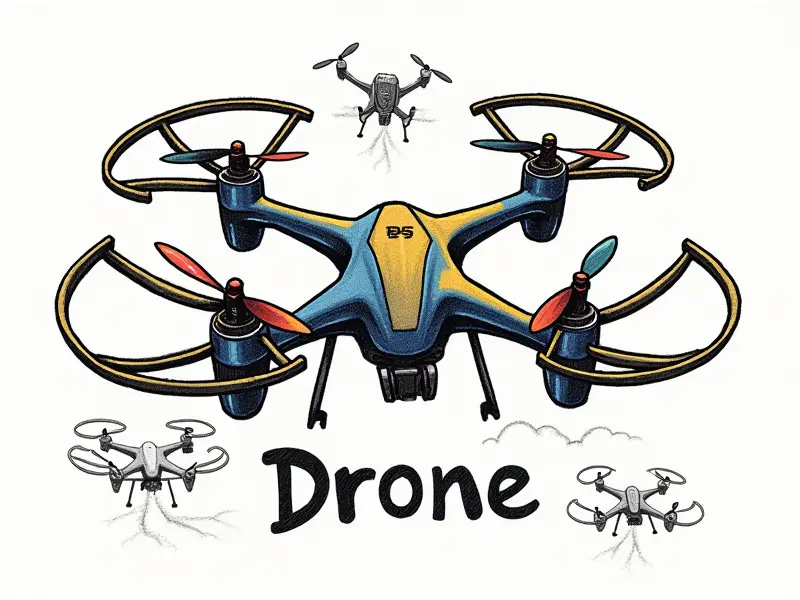How fast can FPV drones fly?

Top Speeds of FPV Racing Drones Revealed
The world of First-Person View (FPV) drone racing is a thrilling spectacle, where speed and agility reign supreme. These high-performance drones are engineered to reach incredible velocities that push the boundaries of what’s possible in aerial sports. In this article, we’ll delve into the top speeds achieved by FPV racing drones, uncovering the secrets behind their blistering performance.
How Fast Can FPV Drones Really Fly?
The question on everyone's mind is how fast can these drones actually go? The answer varies depending on several factors such as drone design, motor power, propeller size, and battery capacity. Typically, an entry-level racing drone might achieve speeds of around 50-60 mph (80-97 km/h), while high-end models can reach up to 120 mph (193 km/h) or more in optimal conditions.
Secrets to Maximizing Your FPV Drone's Speed
To get the most out of your FPV racing drone, there are several key factors you need to consider:
- Motor and Propeller Selection: High-performance motors paired with optimized propellers can significantly boost speed.
- Battery Capacity: Using high-capacity batteries ensures sustained power throughout flights, maintaining peak performance.
- Airframe Design: Streamlined designs reduce drag and allow for better aerodynamics, enhancing overall speed.
Unleashing the Speed Potential of FPV Drones
To unleash the full potential of your FPV drone, it’s crucial to fine-tune its settings. This includes adjusting motor power curves, propeller pitch, and frame tuning for optimal balance between speed and stability.
Exploring Maximum Speed in FPV Racing
The pursuit of maximum speed in FPV racing is not just about raw velocity; it’s also about precision and control at high speeds. Racers must master the art of flying their drones to the absolute limit while maintaining maneuverability and responsiveness.
The Ultimate Guide to FPV Drone Speeds
Understanding the nuances of achieving top speeds with your FPV drone is essential for any serious racer or enthusiast. This guide covers everything from selecting the right components to optimizing flight settings, ensuring you’re ready to hit the skies at breakneck speed.
Battery and Power Management
Efficient power management is crucial for maintaining high speeds over extended periods. High-capacity batteries with balanced voltage profiles are key to sustaining top performance throughout a race or flight session.
Airframe Design Considerations
The aerodynamic design of your drone plays a critical role in maximizing speed. A well-optimized frame reduces drag and allows for better airflow, enabling the drone to achieve higher velocities with less resistance.
Breaking Down FPV Drone Max Speeds
To truly understand how fast FPV drones can fly, it’s important to break down the factors that contribute to maximum speeds. From motor power output to propeller efficiency and frame aerodynamics, each component plays a vital role in achieving top velocities.
Motor Power Output
The strength of your motors directly impacts how fast your drone can fly. High-torque motors with efficient cooling systems are essential for sustained high-speed performance.
Propeller Efficiency
Optimized propellers designed specifically for racing enhance lift and thrust, allowing the drone to achieve higher speeds while maintaining stability.
Achieving High Speeds with FPV Drones
To maximize your FPV drone's speed, focus on optimizing these key areas:
- Motor Tuning: Adjust motor power curves for optimal performance at high speeds.
- Battery Selection: Choose batteries with the highest capacity and voltage stability.
- Airframe Configuration: Optimize your frame design to reduce drag and improve aerodynamics.
Secrets of Achieving High Speed with FPV Drones
The secrets to achieving high speeds with FPV drones often lie in the details. Fine-tuning motor settings, selecting the right propellers, and optimizing your airframe design can make all the difference between average performance and record-breaking speed.
Motor Power Curves
Tuning the power curves of your motors ensures optimal thrust at high RPMs, crucial for reaching top speeds without compromising stability.
Propeller Pitch Adjustment
Adjusting propeller pitch can significantly impact lift and thrust efficiency, allowing you to fine-tune performance for maximum speed.
The Fastest FPV Drones in the Sky Today
Several models stand out as the fastest FPV drones currently available:
- RacingRaven X250 V3: Known for its exceptional performance and high-speed capabilities.
- Holybro Dingo 2: A top contender with impressive speed and maneuverability.
- TBS Volt V4: Offers a perfect blend of power, stability, and aerodynamics.
RacingRaven X250 V3
The RacingRaven X250 V3 is renowned for its high-speed performance and robust design. It features powerful motors and optimized propellers that enable it to reach top speeds effortlessly.
Holybro Dingo 2
The Holybro Dingo 2 offers a unique combination of speed and agility, making it a favorite among FPV racers. Its advanced airframe design reduces drag and enhances aerodynamics for superior performance.
TBS Volt V4
The TBS Volt V4 is celebrated for its balanced approach to high-speed racing. With efficient motor systems and optimized propellers, it delivers exceptional speed while maintaining stability and control.
The Fastest FPV Drones on the Market
When choosing an FPV drone for maximum speed, consider these top contenders:
- RacingRaven X250 V3
- Holybro Dingo 2
- TBS Volt V4
Each of these models offers unique advantages in terms of speed, stability, and overall performance. Whether you’re a seasoned racer or just starting out, one of these drones is sure to provide an exhilarating flying experience.
Conclusion
The world of FPV drone racing continues to evolve with advancements in technology and design, pushing the boundaries of what’s possible in terms of speed. By understanding the key factors that influence top speeds—motor power, propeller efficiency, battery capacity, and aerodynamic design—you can maximize your drone's performance and achieve incredible velocities.
Whether you’re tuning an existing setup or looking to purchase a new high-speed FPV drone, focusing on these critical areas will help you unlock the full potential of your flying machine. Stay tuned for more insights into the exciting world of FPV racing!

